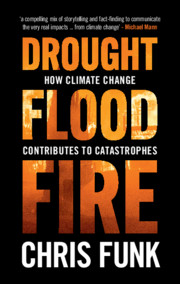Book contents
- Drought, Flood, Fire
- Drought, Flood, Fire
- Copyright page
- Contents
- Acknowledgments
- 1 Climate Extremes, Climate Attribution, Extreme Event Attribution
- 2 Welcome to an Awesome Planet
- 3 The Earth Is a Negentropic System, or “the Bright Side of Empty”
- 4 Do-It-Yourself Climate Change Science
- 5 Temperature Extremes – Impacts and Attribution
- 6 Precipitation Extremes
- 7 Hurricanes, Cyclones, and Typhoons
- 8 Conceptual Models of Climate Change and Prediction, and How They Relate to Floods and Fires
- 9 Climate Change Made the 2015–2016 El Niño More Extreme
- 10 Bigger La Niñas and the East African Climate Paradox
- 11 Fire and Drought in the Western United States
- 12 Fire and Australia’s Black Summer
- 13 Driving toward +4°C on a Dixie® Cup Planet
- 14 We Can Afford to Wear a White Hat
- Appendix A Few Resources for Further Reading and Research
- Index
9 - Climate Change Made the 2015–2016 El Niño More Extreme
Published online by Cambridge University Press: 01 June 2021
- Drought, Flood, Fire
- Drought, Flood, Fire
- Copyright page
- Contents
- Acknowledgments
- 1 Climate Extremes, Climate Attribution, Extreme Event Attribution
- 2 Welcome to an Awesome Planet
- 3 The Earth Is a Negentropic System, or “the Bright Side of Empty”
- 4 Do-It-Yourself Climate Change Science
- 5 Temperature Extremes – Impacts and Attribution
- 6 Precipitation Extremes
- 7 Hurricanes, Cyclones, and Typhoons
- 8 Conceptual Models of Climate Change and Prediction, and How They Relate to Floods and Fires
- 9 Climate Change Made the 2015–2016 El Niño More Extreme
- 10 Bigger La Niñas and the East African Climate Paradox
- 11 Fire and Drought in the Western United States
- 12 Fire and Australia’s Black Summer
- 13 Driving toward +4°C on a Dixie® Cup Planet
- 14 We Can Afford to Wear a White Hat
- Appendix A Few Resources for Further Reading and Research
- Index
Summary
Historically, El Niño events have been associated with droughts and famines. Climate change will make extreme El Niño events more frequent and intense. In 2015–2016, one of the warmest El Niños on record helped trigger massive droughts across Ethiopia, Southern Africa, India, the Maritime Continent, Thailand, Latin America, and Brazil. Exceptionally warm ocean waters decimated fisheries and bleached coral reefs. In Ethiopia and southern Africa, 36 million people were pushed into near-famine conditions. Building on the author’s own research, this chapter examines how climate change has contributed to the ~+0.8°C increase in strong El Niños. In a world without climate change, such a +0.8°C increase would be possible but very unlikely. In a world with climate change, such a change would be very likely. Climate change made the 2015–2016 El Niño more extreme, contributing to Ethiopia’s and southern Africa’s extreme hunger and economic loss. Climate change is hurting people now. Climate change models predict that more extreme El Niños are likely over the next twenty years. The chapter contains a firsthand account from Prosper Chirara, a poor young man from Zimbabwe devastated by drought in 2015 and 2016.
Keywords
- Type
- Chapter
- Information
- Drought, Flood, FireHow Climate Change Contributes to Catastrophes, pp. 186 - 211Publisher: Cambridge University PressPrint publication year: 2021

